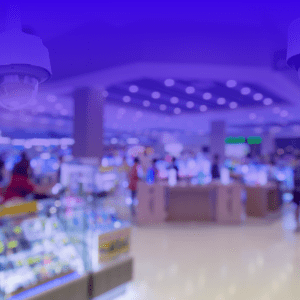






With shoplifting incidents at an all-time high, UK retailers face increasing pressure to protect their stock, employees, and customers. A recent British Retail Consortium survey revealed that the cost of theft doubled to £1.8 billion in 2022/23, with a staggering 45,000 incidents occurring daily. The rising levels of violence and abuse in retail environments—up 50%—have further compounded the problem. For retailers, addressing loss prevention is now more critical than ever.
To stay ahead of these challenges, retailers need more than just awareness—they need practical solutions. From AI-powered surveillance to RFID technology, here are four key areas every retailer should consider when building a robust loss prevention strategy.

1. Integrating AI-Driven Surveillance for Real-Time Alerts
Traditional CCTV systems have evolved into powerful AI-driven surveillance tools. While many retailers already use cameras to monitor stores, adding AI can dramatically improve theft detection. AI software analyses footage in real-time, identifying suspicious behaviours and gestures that human operators might miss. For example, AI can spot when a customer is placing unscanned items in their bag or pockets, and send alerts within seconds, allowing staff to take immediate action.
Tips for implementation:
- Start small: Many AI-powered surveillance systems can integrate with your existing cameras, making it a cost-effective upgrade.
- Focus on key areas: Position cameras strategically in high-traffic and high-risk areas to maximise effectiveness.
- Ensure staff training: Employees need to know how to respond to AI-generated alerts to act quickly and efficiently.
Retailers using AI-integrated CCTV have the opportunity to reduce the number of incidents that occur from shoplifting, as the AI-driven systems can ensure that what leaves the store matches what’s been paid for.
2. Leveraging RFID and Smart Tags to Combat Shrinkage
Radio Frequency Identification (RFID) technology has transformed inventory management for years, but its role in theft prevention is becoming increasingly vital. From an in-store perspective, RFID tags, embedded in products, allow retailers to track items in real time as they move through the store. Smart tags take this further by monitoring variables like motion or pressure, triggering alerts when high-value items are being moved unusually or tampered with.
Retailers such as Tesco, H&M, and Decathlon have already successfully implemented RFID, significantly reducing shrinkage whilst improving inventory accuracy.
RFID extends itself to the wider supply chain too, by providing additional layers of security and traceability in logistics operations, RFID can help support the entire lifecycle of a product, providing visibility and end-to-end security.
A common misconception is that RFID is an expensive solution. Thanks to new entrants to the market and greater availability of technology, RFID has now transitioned from expensive to cost-effective. Therefore, it is worth retailers revisiting this. Ditch plastic pin tags for a more sustainable RFID option to attract your eco-conscious consumers whilst reaching your Environmental, Social, and Governance (ESG) goals.
Tips for implementation:
- Start with high-value items: Use RFID and smart tags for high-ticket products or items frequently targeted by shoplifters.
- Integrate with existing systems: Ensure your RFID system integrates through to an ERP software solution like Merret Pro for real-time stock visibility and smarter stock allocation.
- Monitor key metrics: Measure shrinkage rates before and after implementation to quantify the impact on loss prevention.
RFID and Smart tags are a cost-effective investment that pays off over time, reducing not only theft but also losses from damaged or misplaced inventory.
3. Enhancing Employee Safety with Real-Time Communication Tools

As theft-related violence and abuse in retail environments rise, ensuring employee safety is a critical component of any loss prevention strategy. Real-time communication tools like headsets and body cameras allow staff to stay connected and respond to potential security issues swiftly. These tools enable employees to call for backup or alert colleagues to suspicious behaviour without escalating the situation in front of customers.
Tips for implementation:
- Equip
- frontline staff: Provide headsets and wearable cameras to employees working in vulnerable positions, such as at checkouts or in isolated areas.
- Establish protocols: Train staff on how to use these tools to de-escalate incidents, communicate with colleagues and protect themselves.
- Monitor results: Track the frequency of security incidents and response times to evaluate the effectiveness of these tools.
Communication tools can also help employees feel safer and more supported, which can improve overall morale and productivity.
4. Balancing Loss Prevention with a Seamless Customer Experience
While robust security measures are essential, retailers must also ensure that these efforts don’t alienate customers. The key is to strike the right balance between protection and a frictionless shopping experience. For instance, advanced “scan and go” systems enable customers to check out quickly while reducing opportunities for theft. These systems can scan the contents of a trolley in seconds, verifying purchases by weight and automatically processing the transaction.
In smaller stores, AI-powered self-service checkouts can detect when items are not scanned, providing a non-intrusive way to reduce shrinkage. Luxury retailers are also incorporating biometric systems, such as fingerprint or retina scanners, to restrict access to high-value areas of the store.
Tips for implementation:
- Test new technologies: Begin with a pilot project—such as implementing “scan and go” in a specific store or section—to gather feedback from both customers and staff.
- Optimise for your store size: Choose solutions that are scalable and suited to your store’s size and customer throughput.
- Maintain privacy: Ensure that biometric and other data-driven systems comply with privacy regulations and reassure customers that their information is secure.
Technology such as RFID or AI surveillance can work in the background, protecting your store without disrupting the shopping experience for the customer. Integrating tech seamlessly into store operations creates a win-win for the store and customer satisfaction.
Conclusion

As shoplifting tactics become more sophisticated, retailers must stay proactive by investing in technology that not only prevents theft but also enhances store operations. AI surveillance, RFID, smart tags, and real-time communication tools are powerful solutions that, when combined, create a formidable defence against loss. However, loss prevention isn’t just about installing the latest tech—it’s about finding the right solutions for your business and ensuring they’re used effectively.
Retailers that take a multifaceted approach to security—balancing the needs of their business with the customer experience—will be better positioned to outsmart shoplifters, protect their staff, and maintain profitability in an increasingly challenging retail environment.
To discuss your loss prevention strategy with a member of our team, email sales@barronmccann.com.
